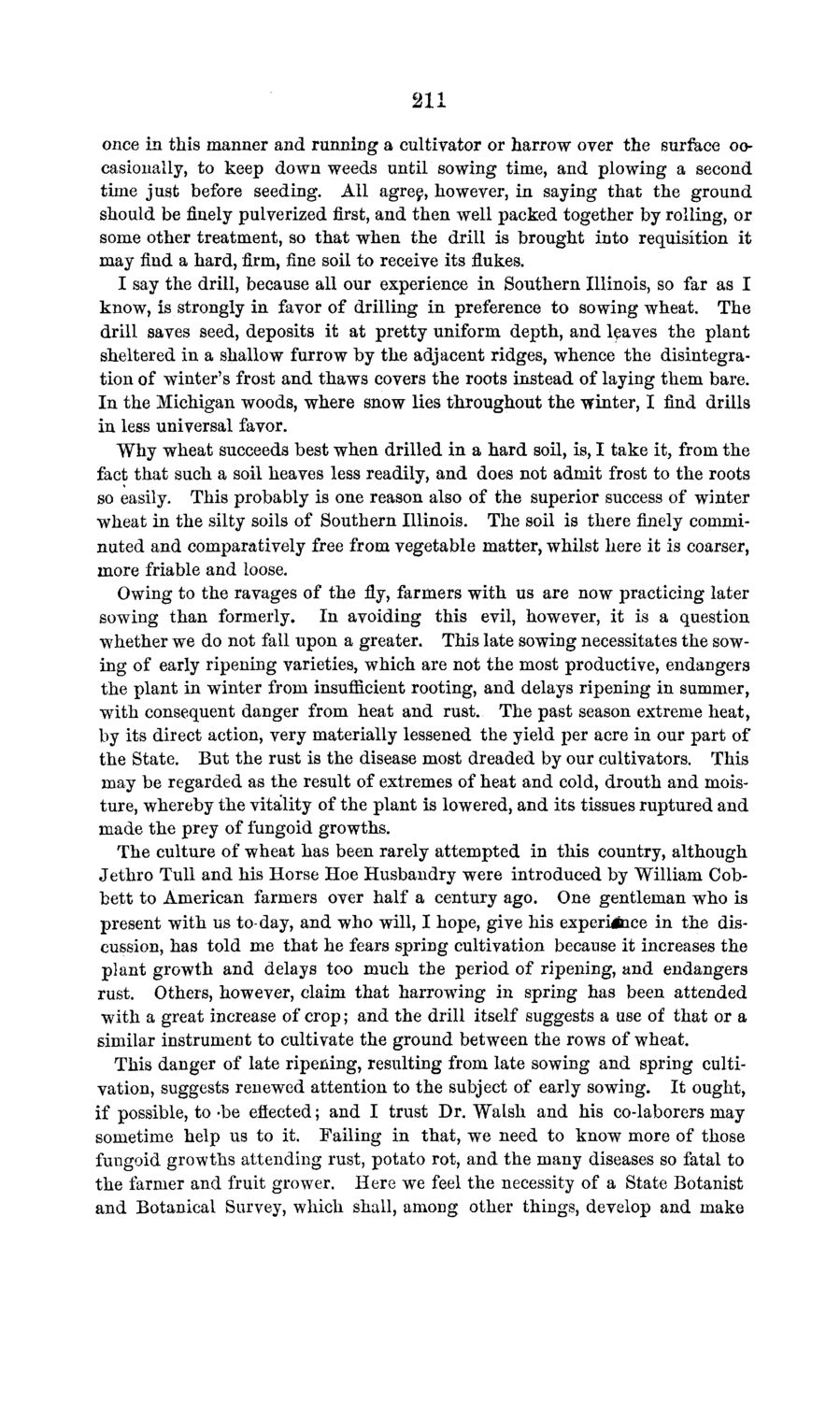| |
| |
Caption: Board of Trustees Minutes - 1869
This is a reduced-resolution page image for fast online browsing.

EXTRACTED TEXT FROM PAGE:
211 once in this manner and running a cultivator or harrow over the surface occasionally, to keep down weeds until sowing time, and plowing a second time just before seeding. All agree, however, in saying that the ground should be finely pulverized first, and then well packed together by rolling, or some other treatment, so that when the drill is brought into requisition it may find a hard, firm, fine soil to receive its flukes. I say the drill, because all our experience in Southern Illinois, so far as I know, is strongly in favor of drilling in preference to sowing wheat. The drill saves seed, deposits it at pretty uniform depth, and leaves the plant sheltered in a shallow furrow by the adjacent ridges, whence the disintegration of winter's frost and thaws covers the roots instead of laying them bare. In the Michigan woods, where snow lies throughout the winter, I find drills in less universal favor. Why wheat succeeds best when drilled in a hard soil, is, I take it, from the fact that such a soil heaves less readily, and does not admit frost to the roots so easily. This probably is one reason also of the superior success of winter wheat in the silty soils of Southern Illinois. The soil is there finely comminuted and comparatively free from vegetable matter, whilst here it is coarser, more friable and loose. Owing to the ravages of the fly, farmers with us are now practicing later sowing than formerly. In avoiding this evil, however, it is a question whether we do not fall upon a greater. This late sowing necessitates the sowing of early ripening varieties, which are not the most productive, endangers the plant in winter from insufficient rooting, and delays ripening in summer, with consequent danger from heat and rust. The past season extreme heat, by its direct action, very materially lessened the yield per acre in our part of the State. But the rust is the disease most dreaded by our cultivators. This may be regarded as the result of extremes of heat and cold, drouth and moisture, whereby the vitality of the plant is lowered, and its tissues ruptured and made the prey of fungoid growths. The culture of wheat has been rarely attempted in this country, although Jethro Tull and his Horse Hoe Husbandry were introduced by William Cobbett to American farmers over half a century ago. One gentleman who is present with us to-day, and who will, I hope, give his experiince in the discussion, has told me that he fears spring cultivation because it increases the plant growth and delays too much the period of ripening, and endangers rust. Others, however, claim that harrowing in spring has been attended with a great increase of crop; and the drill itself suggests a use of that or a similar instrument to cultivate the ground between the rows of wheat. This danger of late ripening, resulting from late sowing and spring cultivation, suggests renewed attention to the subject of early sowing. It ought, if possible, to -be eflected; and I trust Dr. Walsh and his co-laborers may sometime help us to it. Failing in that, we need to know more of those fungoid growths attending rust, potato rot, and the many diseases so fatal to the farmer and fruit grower. Here we feel the necessity of a State Botanist and Botanical Survey, which shall, among other things, develop and make
| |